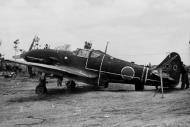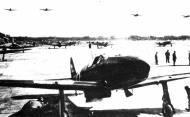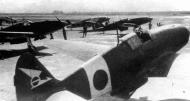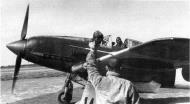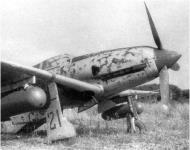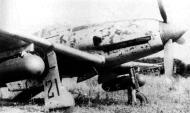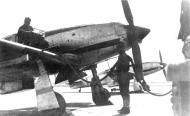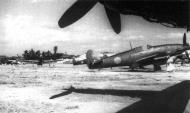Kawasaki Ki-61 Hien 飛燕 - 'Flying Swallow'
| National origin:- Japan |
| Role:- Fighter |
| Manufacturer:- Kawasaki Kōkūki Kōgyō K.K. |
| First flight:- December 1941 |
| Introduction:- 1942 |
| Retired:- 1945 (Japan) |
| Primary users:- Imperial Japanese Army Air Service, Chinese Nationalist Air Force, People's Liberation Army Air Force |
| Produced between 1940–1945:- 3,078 [1] |
| Variants:- Kawasaki Ki-100 |
The Kawasaki Ki-61 Hien (飛燕, 'flying swallow') is a Japanese World War II fighter aircraft used by the Imperial Japanese Army Air Service. The Japanese Army designation was 'Army Type 3 Fighter' (三式戦闘機).[2] Allied pilots initially believed Ki-61s were Messerschmitt Bf 109s and later an Italian aircraft, which led to the Allied reporting name of 'Tony', assigned by the United States War Department.[3] It was the only mass-produced Japanese fighter of the war to use a liquid-cooled inline V engine. Over 3,000 Ki-61s were produced. Initial prototypes saw action over Yokohama during the Doolittle Raid on 18 April 1942, and continued to fly combat missions throughout the war.[4][5]
Design and development
The Ki-61 was designed by Takeo Doi and his deputy Shin Owada in response to a late 1939 tender by the Koku Hombu[N 1] for two fighters, each to be built around the Daimler-Benz DB 601Aa. Production aircraft would use a Kawasaki licensed DB 601, known as the Ha-40, which was to be manufactured at its Akashi plant. The Ki-60 was to be a heavily armed specialised interceptor, with a high wing loading; [N 2] the Ki-61 was to be a more lightly loaded and armed general-purpose fighter, intended to be used mainly in an offensive, air superiority role at low to medium altitudes.[N 3]
Both single-seat, single-engine fighters used the same basic construction, being of all-metal alloys with semi-monocoque fuselages and three-spar wings, with alloy-framed, fabric-covered ailerons, elevators and rudders. Priority was given to the Ki-60, which first flew in April 1941, while design work on the Ki-61 did not begin until December 1940. Although the Ki-61 was broadly similar to the Ki-60, it featured several refinements exploiting lessons learned from the disappointing flight characteristics of the earlier design.[6]
The all-metal, semi-monocoque fuselage was basically oval in cross-section, changing to a tapered, semi-triangular oval behind the cockpit canopy, with a maximum depth of 1.35 m (4 ft 5 in). An unusual feature of the Ki-61 was that the engine bearers were constructed as an integral part of the forward fuselage, with the cowling side panels being fixed. For servicing or replacement, only the top and bottom cowling panels could be removed. A tapered, rectangular supercharger air intake was located on the port-side cowling. Behind the engine bulkhead were the ammunition boxes feeding a pair of synchronized 12.7 mm (.50 in) Ho-103 machine guns which were set in a 'staggered' configuration (the port weapon slightly further forward than that to starboard) in a bay just above and behind the engine. The breeches partly projected into the cockpit, above the instrument panel. The Ho-103 was a light weapon for its caliber (around 23 kg/51 lb) and fired a light shell, but this was compensated for by its rapid rate of fire. The ammunition capacity was limited, having only around 250 rounds for each weapon. A self-sealing fuel tank with a capacity of 165 L (44 US gal) was located behind the pilot's seat. The windshield was armored and there was a 13 mm (.51 in) armor plate behind the pilot. The radiator and oil cooler for the liquid-cooled engine were in a ventral location below the fuselage and wing trailing edge, covered by a rectangular section fairing with a large, adjustable exit flap.[6]
The evenly-tapered wings had an aspect ratio of 7.2 with a gross area of 20 m² (215.28 ft²) and featured three spars; a Warren truss main spar and two auxiliary spars. The rear spar carried the split flaps and long, narrow-chord ailerons, while the front spar incorporated the undercarriage pivot points. The undercarriage track was relatively wide at 4 m (13 ft 1.5 in). Each wing had a partially self-sealing 190 L (50 US gal) fuel tank behind the main spar, just outboard of the fuselage. A single weapon (initially a 7.7 mm/0.303 in Type 89 machine gun) was able to be carried in a weapons bay located behind the main spar.[6]
The first prototype of the San-shiki-Sentohki ichi gata ('Type 3 Fighter, Model 1', the official IJAAF designation) first flew in December 1941 at Kagamigahara Airfield.[7] Although test pilots were enthusiastic about its self-sealing fuel tanks, upgraded armament, and good dive performance, the wing loading of 146.3 kg/m² (30 lb/ft²) at an all-up weight of 2,950 kg (6,500 lb) was viewed with scepticism by many of the senior officers of the Koku Hombu, who still believed in the light, highly manoeuvrable, lightly armed fighter epitomised by the then new Nakajima Ki-43-I-Hei which had a wing loading of 92.6 kg/m² (19 lb/ft²) (and even that was considered borderline compared to the earlier Ki-27).[8]
To address these concerns, Kawasaki staged a fly-off between two Ki-61 prototypes and the Nakajima Ki-43-I, a pre-production Nakajima Ki-44-I, a Lavochkin-Gorbunov-Goudkov LaGG-3 (flown to Manchuria by a defector), a Messerschmitt Bf 109E-3, and a captured Curtiss P-40E Warhawk. The Ki-61 proved the fastest of all the aircraft and was inferior only to the Ki-43 in manoeuvrability.[8][9][10][11]
The Ki-61 was the last of the fighters powered by the DB-601 or its foreign derivatives, and it was soon overshadowed by fighters with more powerful engines. By the time it first flew in December 1941, one year after the Macchi C.202's first flight and three years after the first Bf 109E, the engine was already underpowered compared to the new 1,120 kW (1,500 hp) inline or 1,491 kW (2,000 hp) radial engines being developed (and already nearing the mass-production stage) to power the next generation of combat aircraft such as the Republic P-47 Thunderbolt. Moreover, the inline Ha-40 engine proved to be an unreliable powerplant.[12][13]
The DB-601 engine required precise and sophisticated manufacturing; the Ha-40 was lighter by roughly 30 kg (70 lb) and required even higher manufacturing standards. Reaching these standards proved difficult for Japanese manufacturers, an issue further complicated by the variable quality of materials, fuel, and the lubricants needed to run a sensitive, high-performance engine. The Japanese equivalent of the more powerful DB-605 engine was the Ha-140, which was fitted onto the Type 3 to produce the Ki-61-II high-altitude interceptor.[12][14]
Compared to the Ki-61-I, the Ki-61-II had 10% greater wing area, used more armour and was powered by the Kawasaki Ha-140 engine generating 1,120 kW (1,500 hp). After overcoming initial fuselage and wing stability problems, the new interceptor reverted to the original wing and was put into service as the Ki-61-II-KAI. However, the Ha-140 engine had severe reliability problems which were never fully resolved, and around half of the first batch of engines delivered were returned to the factory to be re-built. A US bombing raid on 19 January 1945 destroyed the engine factory in Akashi, Hyōgo, and 275 Ki-61-II-KAI airframes without engines were converted to use the Mitsubishi Ha-112-II radial engine, resulting in the Ki-100. While the Ha-112 solved the problems encountered with the Ha-140, the new engine still had a major weakness: a lack of power at altitude, which diminished its ability to intercept high-flying B-29 Superfortresses relative to the Ki-61-II.[12][15]
Operational history
The Ki-61 looked so different to the usual radial-engined Japanese fighters that the Allies at first believed it to be of German or Italian origin, possibly a license-built Messerschmitt Bf 109. The first Ki-61 seen by Allied aircrew had been misidentified as a Bf 109 by USAAF Capt. C. Ross Greening during the Doolittle Raid. In early reports, when it was thought to have been a German fighter, the Ki-61 had been code-named 'Mike'.[4][5] The final, and better known code name adopted was 'Tony', because the Ki-61 looked like an Italian aircraft.[17][18]
The new Ki-61 Hien fighters entered service with a special training unit, the 23rd Chutai, and entered combat for first time in early 1943, during the New Guinea campaign.[19] The first Sentai (Air Group/Wing) fully equipped with the Hien was the 68th in Wewak, New Guinea,[19] followed by the 78th Sentai stationed at Rabaul. Both units were sent into a difficult theatre where jungles and adverse weather conditions, coupled with a lack of spares, quickly undermined the efficiency of both men and machines. Because the Ki-61 was so new, and had been rushed into service, it inevitably suffered from teething problems. Almost all of the modern Japanese aircraft engines, especially the Ki-61's liquid-cooled engines, suffered a disastrous series of failures and ongoing problems,[13] which resulted in the obsolescent Ki-43 still forming the bulk of the JAAF's fighter capability.
Initially, this campaign went successfully for the Japanese Army Air Force (JAAF), but when the Allies re-organized and enhanced the combat capabilities of their air forces, they gained the upper hand against the JAAF.[13] High non-combat losses were also experienced by the Japanese during this campaign. For example, while in transit between Truk and Rabaul, the 78th lost 18 of its 30 Ki-61s.[20][21]
Even with these problems, there was some concern in Allied aviation circles regarding the Hien:
The new Japanese fighter caused some pain and consternation among Allied pilots, particularly when they found out the hard way that they could no longer go into a dive and escape as they had from lighter Japanese fighters. ...General George Kenney [Allied air forces commander in the Southwest Pacific] found his Curtiss P-40s completely outclassed, and begged for more Lockheed P-38 Lightnings to counter the threat of the new enemy fighter.
However, the increasing numerical strength of Allied bomber units, along with inadequate anti-aircraft systems, imposed crippling losses on Japanese units. Approximately 100 out of 130 Japanese aircraft based in the Wewak area were lost during the attacks of August 17–21 1943. By the end of the campaign, nearly 2,000 Japanese aircraft had been lost in air attacks from up to 200 Allied aircraft at a time, around half of which were Consolidated B-24 Liberators and North American B-25 Mitchells armed with fragmentation bombs.[13] After the Japanese retreat, over 340 aircraft wrecks were later found at Hollandia.[13]
The Ki-61 was also utilised in Southeast Asia, Okinawa, China and as an interceptor during US bombing raids over Japanese home islands, including against Boeing B-29 Superfortresses. The Ki-61 was notable for many reasons: initially identified as of either German or Italian origin, these aircraft were capable of matching Allied aircraft such as the P-40 in speed, and as evaluation had already showed, were superior in almost every respect. However, the armament of the early Hien was lighter, but still sufficient for most purposes. Some authors claim that the Lockheed P-38 Lightning was measurably superior.[22] The Ki-61 carried a great deal of fuel, but due to having self-sealing fuel tanks it was not considered readily flammable, as many other Japanese aircraft were.[12]
Owing to the additional weight, the Ki-61's performance and agility suffered when its armament was increased, but it still remained capable with a 580 km/h (313 kn) maximum speed. The cannon armament was needed to counter the Allied bombers, which proved to be difficult to shoot down with only 12.7 mm (.50 in) machine guns. The empty and maximum weights for the Ki-61 prototype (2 × 12.7 mm/0.50 in + 2 × 7.7 mm/0.303 in) were 2,238 kg (4,934 lb) and 2,950 kg (6,504 lb), respectively; for the Ki-61-I basic (4 × 12.7 mm/.50 in) 3,130 kg (6,900 lb); and for the Ki-61-KAI (2 × 12.7 mm/0.50 in + 2 × 20 mm), 2,630 kg (5,798 lb) and 3,470 kg (6,750 lb).[12]
A number of Ki-61s were also used in Tokkotai (kamikaze) missions launched toward the end of the war. The Ki-61 was delivered to 15th Sentai (group/wing), as well as some individual Chutaicho (junior operational commanders) in other Sentai, and even to operational training units in the JAAF. The aircraft was largely trouble-free in service except for the liquid-cooled engine which tended to overheat when idling on the ground and suffered from oil circulation and bearing problems.[23]
Ki-61 Special Attack Unit
The tactic of using aircraft to ram American Boeing B-29 Superfortresses was first recorded in late August 1944, when B-29s from Chinese airfields attempted to bomb the steel factories at Yawata. Sergeant Shigeo Nobe of the 4th Sentai intentionally flew his Kawasaki Ki-45 into a B-29; debris from the explosion severely damaged another B-29, which also went down.[N 4][24] Other attacks of this nature followed, as a result of which individual pilots determined it was a practicable way of destroying B-29s.[25]
On 7 November 1944, the officer commanding the 10th Hiko Shidan (Air division) made ramming attacks a matter of policy by forming ramming attack flights specifically to oppose the B-29s at high altitude. The aircraft were stripped of their fuselage armament and protective systems in order to attain the required altitudes. Although the term 'kamikaze' is often used to refer to the pilots undertaking these attacks, the word was not used by the Japanese military.
The units assigned to the 10th Hiko Shidan included the 244th Hiko Sentai (Fighter group), then commanded by Captain Takashi Fujita, who organised a ramming flight called 'Hagakure-Tai' ('Special Attack Unit'), which was composed out of volunteers from the three Chuatai (squadrons) of the 244th: the 1st Chutai 'Soyokaze', 2nd Chutai 'Toppu', and the 3rd Chutai known as 'Mikazuki'.
First Lieutenant Toru Shinomiya was selected to lead the Hagakure-Tai. On 3 December 1944, Shinomiya – along with Sergeant Masao Itagaki and Sergeant Matsumi Nakano – intercepted a B-29 raid; Shinomaya rammed one B-29, but was able to land his damaged Ki-61, which had lost most of the port outer wing, back at base. After attacking another B-29 Itagaki had to parachute from his damaged fighter, while Nakano rammed and damaged Long Distance of the 498th BG and crash-landed his stripped-down Ki-61 in a field. Shinomaya's damaged Ki-61 was later displayed inside Tokyo's Matsuya department store while Nakano's Ki-61 was displayed outside, alongside of a life-size cut-away drawing of the forward fuselage of a B-29.[26][N 5] These three pilots were the first recipients of the Bukosho, Japan's equivalent to the Victoria Cross or Medal of Honor, which had been inaugurated on 7 December 1944 as an Imperial Edict by Emperor Hirohito (there are 89 known recipients, most of whom fought and scored against B-29s).[27][28] The existence of the ramming unit had been kept confidential until then, but it was officially disclosed in the combat results announcement and officially named 'Shinten Seiku Tai' ('Body Attack Detachment') by the Defense GHQ. On 27 January 1945, Itakagi survived another ramming attack on a B-29, again parachuting to safety, and received a second Bukosho; he survived the war as only one of two known double-Bukosho recipients.[29] Sergeant Shigeru Kuroishikawa was another distinguished member of the unit.
Despite their successful attacks, these pilots gained no reprieve, and were obliged to continue these deadly and dangerous ramming tactics until they were killed, or else wounded so badly that they could no longer fly. They were regarded as doomed men and were celebrated among the ranks of those who were going to certain death as Tokkotai (kamikaze) pilots.[30]
Some other Ki-61 pilots also achieved renown, among them Major Teruhiko Kobayshi of the 244th Sentai, who was credited by some with a dozen victories mostly due to conventional attacks against B-29s.[31]
Ki-61 units
The Hiko Sentai, usually referred to as Sentai, was the basic operational unit of the Imperial Japanese Army Air Force, composed of three or more Chutai (companies or squadrons). A Sentai had 27 to 49 aircraft, with each Chutai having 16 aircraft and pilots plus a maintenance and repair unit. Several sentai had other units under their operational control, most notably the Hagakure-Tai ('Special Attack Units') of the 244th Sentai. By 1944, with the depredations of Allied attacks on supply lines and airfields, as well as the loss of pilots and aircraft through combat attrition and accidents, few sentai were able to operate at full strength.
Units operating the Ki-61 Hien data from[32][33]
| Sentai |
Established |
Aircraft Type(s) |
Area of Operations |
Disbanded |
Remarks |
| 17th |
10 February 1944 at Kagamigahara, Gifu Prefecture [N 6] |
Ki-61, Ki-100 |
Philippines, Formosa, Japan |
End of War |
One of Kawasaki's main factories was located at Kagamigahara which, in 1944 was not yet a city. |
| 18th |
10 February 1944 at Chōfu from the 244th Sentai |
Ki-61, Ki-100 |
Philippines, Japan |
End of War |
Lt Mitsuo Oyake won Bukosho for shooting down three B-29s (one by ramming) 7 April 1944 and damaging three others. |
| 19th |
10 February 1944 at Akeno Fighter School |
Ki-61 |
Indonesia, Philippines, Formosa, Okinawa |
End of War (Formosa) |
|
| 23rd |
11 October 1944 at Inba, Chiba Prefecture |
Ki-43, Ki-44, Ki-61 |
Iwo Jima, Formosa, Japan |
End of War (Inba) |
|
| 26th |
Late 1944 |
Ki-51, Ki-43, Ki-61 |
Formosa |
End of War (Formosa) |
|
| 28th |
June 1939 in Manchuria |
Ki-46, Ki-61, Ki-102 |
Manchuria, Japan |
July 1945 |
|
| 31st |
July 1938 in China |
Ki-10, Ki-43, Ki-61 |
Manchuria, Philippines |
30 May 1945 at Singapore |
|
| 33rd |
Late 1943 |
Ki-10, Ki-27, Ki-43, Ki-61 |
New Guinea, Manchuria (Manchoukuo), East Indies |
End of War, Medan, Dutch East Indies |
|
| 53rd |
23 March 1944 at Tokorozawa, Saitama |
Ki-61, Ki-45 |
Japan, Eastern Defence Sector |
|
flew Ki-61 for a short time in Home Island Defence |
| 55th |
30 May 1944 at Taishō, Osaka Prefecture |
Ki-61 |
Philippines, Japan |
End of War at Sana, Nara Prefecture |
|
| 56th |
August 1944 at Taishō Osaka Prefecture |
Ki-61 |
Japan |
End of War at Itami, Hyōgo Prefecture |
Unit claimed 11 B-29s for 30 pilots lost. Warrant Officer Tadao Sumi (five B-29s plus one P-51 destroyed, four B-29s damaged) Bukosho recipient. |
| 59th |
1 July 1938 at Kagamigahara, Gifu Prefecture |
Ki-27, Ki-43, Ki-61, Ki-100 |
China, Manchuria (Nomonhan), Indochina, East Indies, New Guinea, Okinawa, Japan |
End of War at Ashiya, Fukuoka Prefecture |
1st Lieutenant Naoyuki Ogata Bukosho recipient. Warrant Officer Kazuo Shimizu flew with unit from February 1942 right through to August 1945; 18 victories, including nine bombers. |
| 65th |
|
Ki-32, Ki-51, Ki-43, Ki-61, Ki-45 |
Philippines, Formosa, Okinawa, Japan |
End of War, Metabaru, Saga |
Unit used Ki-61 from the summer of 1944 |
| 68th |
March 1942 at Harbin, Manchuria |
Ki-27, Ki-61 |
Rabaul (New Britain), New Guinea, Halmahera |
25 July 1944 |
First unit to convert to the Ki-61. Unit was destroyed by Allied air forces in New Guinea. Most surviving ground and aircrew were used as infantry, with few survivors. A Ki-61-1-Otsu, manufacturer's No. 640 is one of the best preserved aircraft wrecks in New Guinea. Captain Shogo Takeuchi transferred from 64th Sentai April 1942. KIA 15 December 1943 30+ victories.[34] Sgt. Susumu Kaijinami officially credited with eight victories plus 16 unofficially. |
| 78th |
31 March 1942 in China |
Ki-27, Ki-61 |
Manchuria, Rabaul, New Guinea |
25 July 1944 |
Second unit to convert to the Ki-61. Unit was destroyed by Allied air forces in New Guinea. Most surviving ground and aircrew were used as infantry, with few survivors. |
| 105th |
August 1944, Taichung, Formosa |
Ki-61 |
Okinawa, Formosa |
End of War (Formosa) |
|
| 244th |
April 1942, reorganised from 144th Sentai |
Ki-27, Ki-61, Ki-100 |
Okinawa, Formosa |
End of War (Yokaichi, Shiga Prefecture) |
Nine Bukosho recipients. Major Teruhiko Kobayashi JAAF's youngest Sentai commander. Also had an air-to-air B-29 ramming unit. Sentai claimed 73 B-29s shot down plus 92 damaged. Most famous of the Home Defence Sentais. Captain Nagao Shirai considered the ranking ace of 244 Sentai and possibly leading B-29 'killer' of JAAF (11 B-29s plus two F6Fs destroyed, six other aircraft damaged using Ki-61 and Ki-100. Captain Chuichi Ichikawa nine B-29s plus one F6F destroyed, six B-29s damaged. Major Teruhiko Kobayashi, three B-29s plus two F6Fs destroyed. |
| Training Units |
| 23rd Dokuritsu Dai Shijugo (Independent Chutai) |
Chōfu, 1941 |
Ki-61 |
Japan |
Became basis of 23rd Sentai |
Evaluation and conversion unit for Ki-61. |
| Akeno Fighter School |
Akeno, Mie Prefecture, 1935 |
Ki-10, Ki-27, Ki-43, Ki-44, Ki-45, Ki-61, Ki-84, Ki-100 |
Japan |
End of War |
Main flight training school for Army fighter pilots. Many of the instructors participated in missions in defence of Japan 1944-1945. Akeno Airbase still in operational use. |
| 37th Kyoiku Hikotai (Flight Training Company) |
Matsuyama airfield, Formosa, 1943[35] |
Ki-43, Ki-44, Ki-45, Ki-61, Ki-84 |
Formosa |
End of War |
Flight training school for Army fighter pilots. Many of the instructors participated in missions in defence of Japan 1944-1945 |
Ki-61-I Production: Kawasaki Kokuki K.K [36]
| Year |
Jan. |
Feb. |
Mar. |
Apr. |
May |
June |
July |
Aug. |
Sept. |
Oct. |
Nov. |
Dec. |
Annual |
| 1942 |
|
|
|
|
|
|
|
1 |
3 |
5 |
10 |
15 |
34 |
| 1943 |
22 |
32 |
31 |
37 |
44 |
40 |
53 |
60 |
70 |
87 |
104 |
130 |
710 |
| 1944 |
150 |
156 |
145 |
142 |
118 |
236 |
254 |
198 |
164 |
174 |
101 |
53 |
1,891 |
| 1945 |
19 |
|
|
|
|
|
|
|
|
|
|
|
19 |
| Total |
|
|
|
|
|
|
|
|
|
|
|
|
2,654 |
Not included:
Pre-production started with the first prototype completed in July 1941,[37] and with further eleven builds in early 1942.[38]
Ki-61-II Production: Kawasaki Kokuki K.K [36]
| Year |
Jan. |
Feb. |
Mar. |
Apr. |
May |
June |
July |
Aug. |
Sept. |
Oct. |
Nov. |
Dec. |
Annual |
| 1944 |
1 |
3 |
26 |
0 |
0 |
0 |
0 |
1 |
26 |
41 |
71 |
70 |
239 |
| 1945 |
68 |
56 |
15 |
19 |
7 |
|
|
|
|
|
|
|
165 |
| Total |
|
|
|
|
|
|
|
|
|
|
|
|
404 |
Note:
Out of 374 Ki-61-II builds, 275 were completed as Ki-100 Ia.[1]
Not included:
Pre-production started with eight prototypes completed during Aug. 1943 to Jan. 1944.[1]
Total Production: Kawasaki Ki-61
| According to USSBS Report: 3,058 [36] |
Figure includes: 2,654 Ki-61-I and 404 Ki-61-II builds |
| According to Francillon: 3,078 [1] |
Figure includes: 2,666 Ki-61-I and 412 Ki-61-II builds |
Variants
Note: Ko, Otsu, Hei and Tei are the Japanese equivalents to a, b, c, d. Kai ('modified' or 'improved') was also used for some models of the Ki-61.
Ki-61 12 original prototypes.
Ki-61-I-Ko The first production version. This version had a fully-retractable tailwheel and two 7.7 mm (0.303 in) Type 89 machine guns in the wings and two synchronized 12.7 mm (0.50 in) Ho-103 machine guns in the fuselage forward decking. The wings had racks outboard of the wheelwells, which were capable of carrying one 151 L (40 gal) drop tank or a light bomb. Weights: 2,238-2,950 kg (wing loading 147 kg/m2).[12]
Ki-61-I-Otsu The second production fighter variant. As it was found the armament was too light against allied aircraft and the tailwheel retraction mechanism was unreliable, the aircraft was modified accordingly. Two 12.7 mm (.50 in) Ho-103 machine guns replaced the wing 7.7 mm (.303 in) machine guns, with modifications to the upper-wing bulges, and the tailwheel doors were removed and the tailwheel locked in the 'down' position (although the mechanism was still intact). Max takeoff weight 3,130 kg.[12]
Ki-61-I-Hei 800 German-made 20 mm Mauser MG 151/20 cannons and ammunition supplies were imported to Japan by submarine. The Hei was built in conjunction with the Otsu variant on the Kawasaki production lines but some 'conversion kits' were directly sent to New Guinea. In this variant, the wing machine guns were replaced by Mauser cannons. The fuselage was longer (engine bulkhead forwarded of 19 cm, added a small fuel tank). Trial fittings found that these could be placed into the existing wing if the gun was laid on its side and a fairing was provided on the underside of the wing for clearance of the breech mechanism. 388 Ki-61s were so modified; the first of these was completed in September 1943 or January 1944. The last was completed in July 1944. Max takeoff weight 3,470 kg, max speed 580 km/h at 5,000 m, time to that height was seven minutes.
Ki-61-I-Tei This machine featured two 12.7 mm (.50 in) Ho-103s in the modified (stronger) wings, provisions of external storage using fixed underwing pylons, and a non-retractable tail wheel. The forward fuselage was elongated by 190 mm (7.5 in) just after the exhaust line and forward of the windscreen to make room for the installation of Japanese 20 mm Ho-5 cannon in the fuselage decking (the same as with Hei version). The continued supply of MG 151's via submarine was not able to be guaranteed and the Ho-5 was ready. Several internal changes were also made. These included the simplification of several systems for increased dependability and ease of maintenance. The rear section of the fuselage was also made to be easily removable to further facilitate the ease of repair work. There is now some doubt as to whether the Tei ('d') designation was used.
Ki-61-I-KAId Interceptor variant with 2 × 12.7 mm (.50 in) fuselage machine guns and 2 × 30 mm (1.18 in) wing cannon.
Ki-61-I- w.c.e.s. An experimental aircraft with a wing cooling evaporation system, modelled on that used by the Heinkel He 100. It was the fastest Ki-61 built, achieving 630 km/h (395 mph), and the last with a retractable tail wheel.
Ki-61-II Prototype with 10% greater wing area and a slightly different airfoil. An Ha-140 engine with 1,120 kW (1,500 hp) for takeoff was fitted; the cowling panels were redesigned and the supercharger air intake was longer. A redesigned windscreen incorporating an extra panel was mounted further forward. The transparency to the rear of the sliding canopy was redesigned to increase rearward visibility. The prototype was first flown in December 1943; flight trials showed that the new wing was unsatisfactory and only eight Ki-61-IIs were built. The Ki-61-II was one of only very few Japanese aircraft able to reach the operational altitude of the B-29s raiding Japan with decent firepower. Subsequently, the majority of B-29s lost to Japanese fighters were shot down by the Ki-61-II.
Note Because of the unreliability of the Ha-140 and the destruction of the Akashi plant by a B-29 bombing attack the bulk of the Ki-61-II-KAIs built were airframes only, which were later converted to Ki-100-Is. ;Ki-61-II-KAI Pre-production version which reverted back to the Ki-61-I-Tei wing, a 220 mm (8.7 in) fuselage stretch, enlarged rudder, and Ha-140 engine; 30 built.
Ki-61-II-KAIa Armed with 2 x 12.7 mm (.50 in) machine guns in the wings and 2 x 20 mm cannon in the fuselage.
Ki-61-II-KAIb Armed with 4 x 20 mm cannon.
Ki-61-III One prototype only. This version had a cut-down rear fuselage and a canopy design which was later used by the Ki-100-II.
A total of 3,159 Ki-61 were built.
Operators
Wartime
Japan :- Imperial Japanese Navy Air Service
Post-war
Indonesia :- Indonesian Air Force - In 1945, Indonesian People's Security Force (IPSF) (Indonesian pro-independence guerrillas) captured a small number of aircraft at numerous Japanese air bases, including Bugis Air Base in Malang (repatriated 18 September 1945). Most aircraft were destroyed in military conflicts between the Netherlands and the newly proclaimed-Republic of Indonesia during the Indonesian National Revolution of 1945–1949.[39]
People's Republic of China :- People's Liberation Army Air Force operated captured aircraft from 1945 until the 1950s.
Chinese Nationalist Air Force Also operated some captured aircraft
Survivors
Three airframes are known to exist:
A Ki-61-II-Kai (Ser. no. 5017 ) is on static display at the Tokko Heiwa Kaikan Museum in Chiran Kagoshima Prefecture, Kyushu, Japan.[40]
A Ki-61 (unknown type and serial number) is owned by Kermit Weeks' Fantasy of Flight museum. It is currently stored and in need of restoration.
A Ki-61-I-Otsu ( Ser. no. 640 ) is currently under restoration to flying condition at Wangaratta, Australia and will become part of the Military Aviation Museum collection in Virginia Beach, Virginia, USA.

 Editor for Asisbiz: Matthew Laird Acred
Editor for Asisbiz: Matthew Laird Acred


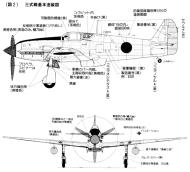
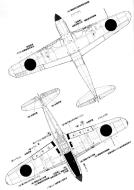
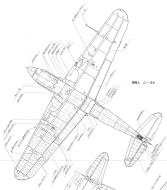










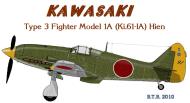














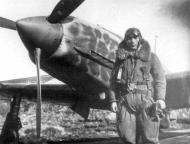

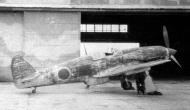
-36.jpg)
-37.jpg)
-37-B.jpg)
